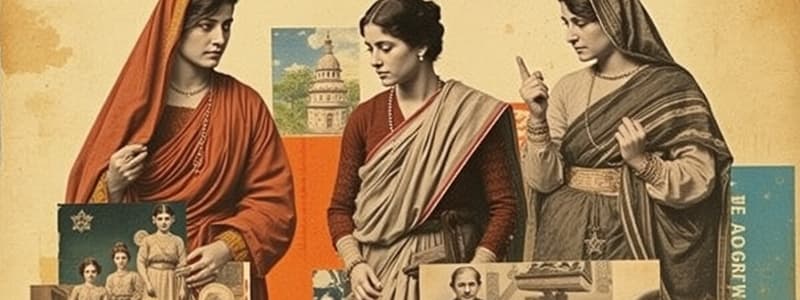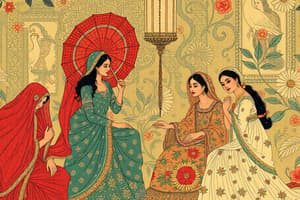Podcast
Questions and Answers
Who was the Maratha king that opposed Brahmanical dominance?
Who was the Maratha king that opposed Brahmanical dominance?
- E.V.Ramasamy Naicker
- Dr.B.R.Ambedkar
- Jyotiba Phule
- Shahu Maharaj (correct)
Haridas Thakur Mata Sect worked primarily among the upper-caste population.
Haridas Thakur Mata Sect worked primarily among the upper-caste population.
False (B)
Who is known for advocating caste equality in Kerala?
Who is known for advocating caste equality in Kerala?
Shri Narayana Guru
The political party formed by Non-Brahmin leaders in 1916 is known as the __________.
The political party formed by Non-Brahmin leaders in 1916 is known as the __________.
Match the following figures with their contributions:
Match the following figures with their contributions:
Which movement challenged the caste system in central India?
Which movement challenged the caste system in central India?
Christian missionaries primarily focused on educating upper-caste individuals.
Christian missionaries primarily focused on educating upper-caste individuals.
Who rejected the caste system and promoted equality among all humans?
Who rejected the caste system and promoted equality among all humans?
The migration of people to cities created new demands for __________ jobs.
The migration of people to cities created new demands for __________ jobs.
Match the following cast reform movements with their key focus areas:
Match the following cast reform movements with their key focus areas:
Which of the following individuals founded the Satyashodhak Samaj?
Which of the following individuals founded the Satyashodhak Samaj?
The Temple Entry Movement was led by Shri Narayan Guru.
The Temple Entry Movement was led by Shri Narayan Guru.
Who founded the Brahmo Samaj and advocated for women's equality and education?
Who founded the Brahmo Samaj and advocated for women's equality and education?
The practice of Sati was designed to empower women in society.
The practice of Sati was designed to empower women in society.
What was the main focus of the Satnami Movement?
What was the main focus of the Satnami Movement?
In what year was the practice of Sati banned?
In what year was the practice of Sati banned?
In the 19th century, many lower caste individuals migrated to cities due to __________.
In the 19th century, many lower caste individuals migrated to cities due to __________.
The organization founded in 1840 in Bombay that promoted spiritual equality among all castes is called __________.
The organization founded in 1840 in Bombay that promoted spiritual equality among all castes is called __________.
Match the following reformers with their contributions:
Match the following reformers with their contributions:
Which movement was particularly strong in Maharashtra?
Which movement was particularly strong in Maharashtra?
Which prominent reformer established a widow's home in Pune?
Which prominent reformer established a widow's home in Pune?
Muslim women primarily learned to read the Quran in Arabic at schools outside their homes.
Muslim women primarily learned to read the Quran in Arabic at schools outside their homes.
The Haridas Thakur Mata Sect supported the caste system.
The Haridas Thakur Mata Sect supported the caste system.
By the 1880s, women began to pursue careers in __________ and teaching.
By the 1880s, women began to pursue careers in __________ and teaching.
What book did Jyotiba Phule publish in 1873, and what was its focus?
What book did Jyotiba Phule publish in 1873, and what was its focus?
Match the following reformers with their contributions:
Match the following reformers with their contributions:
Flashcards
Sati
Sati
A practice in which a Hindu widow would immolate herself on her deceased husband's funeral pyre, considered a mark of virtue.
Jyotiba Phule
Jyotiba Phule
A prominent social reformer who advocated for the rights of the lower castes in 19th-century India. He argued that the land belonged to indigenous people who were often classified as lower castes.
Limited Education for Women
Limited Education for Women
Restriction on education for women, especially widows, who faced limited opportunities in 19th-century India.
Raja Ram Mohan Roy
Raja Ram Mohan Roy
Signup and view all the flashcards
Haridas Thakur Mata Sect
Haridas Thakur Mata Sect
Signup and view all the flashcards
Dr. B.R. Ambedkar
Dr. B.R. Ambedkar
Signup and view all the flashcards
Brahmo Samaj
Brahmo Samaj
Signup and view all the flashcards
Justice Party
Justice Party
Signup and view all the flashcards
Widow Remarriage
Widow Remarriage
Signup and view all the flashcards
Arya Samaj
Arya Samaj
Signup and view all the flashcards
E.V. Ramasamy Naicker
E.V. Ramasamy Naicker
Signup and view all the flashcards
Jyotirao Phule
Jyotirao Phule
Signup and view all the flashcards
Pandita Ramabai
Pandita Ramabai
Signup and view all the flashcards
Satnami Movement
Satnami Movement
Signup and view all the flashcards
Shri Narayan Guru
Shri Narayan Guru
Signup and view all the flashcards
Christian Missionaries' Role in Social Reform
Christian Missionaries' Role in Social Reform
Signup and view all the flashcards
Colonial Influence on Social Reform
Colonial Influence on Social Reform
Signup and view all the flashcards
What was Sati?
What was Sati?
Signup and view all the flashcards
What was the Brahmo Samaj?
What was the Brahmo Samaj?
Signup and view all the flashcards
Who was Jyotirao Phule?
Who was Jyotirao Phule?
Signup and view all the flashcards
What was 'Gulamgiri'?
What was 'Gulamgiri'?
Signup and view all the flashcards
What was the Paramhansa Mandali?
What was the Paramhansa Mandali?
Signup and view all the flashcards
What was the Non-Brahman Movement?
What was the Non-Brahman Movement?
Signup and view all the flashcards
Who was Dr. B.R. Ambedkar?
Who was Dr. B.R. Ambedkar?
Signup and view all the flashcards
What was the Justice Party?
What was the Justice Party?
Signup and view all the flashcards
What was the 'Paramhans Mandali'?
What was the 'Paramhans Mandali'?
Signup and view all the flashcards
Who was 'Haridas Thakur'?
Who was 'Haridas Thakur'?
Signup and view all the flashcards
Who was Begum Rokeya Sakhawat Hussain?
Who was Begum Rokeya Sakhawat Hussain?
Signup and view all the flashcards
Who was Ishwar Chandra Vidyasagar?
Who was Ishwar Chandra Vidyasagar?
Signup and view all the flashcards
Who was Pandita Ramabai?
Who was Pandita Ramabai?
Signup and view all the flashcards
Satyashodhak Samaj
Satyashodhak Samaj
Signup and view all the flashcards
E.V. Ramasamy Naicker (Periyar)
E.V. Ramasamy Naicker (Periyar)
Signup and view all the flashcards
Gulami
Gulami
Signup and view all the flashcards
Non-Brahman Movement
Non-Brahman Movement
Signup and view all the flashcards
Self-Respect Movement
Self-Respect Movement
Signup and view all the flashcards
Temple Entry Movement
Temple Entry Movement
Signup and view all the flashcards
Labor Migration
Labor Migration
Signup and view all the flashcards
Study Notes
Problems Faced by Women in Early 19th Century India
- Sati: Widows were pressured to commit self-immolation on their husband's funeral pyre, considered virtuous.
- Limited Education: Women, particularly widows, faced significant educational and opportunity restrictions.
- Social Hierarchy: Society was structured by caste, with Brahmins and Kshatriyas as upper castes; Vaishyas as traders/money lenders; and Shudras as lower castes (peasants, artisans, weavers, potters).
- Strict Social Restrictions: Women were subject to numerous social restrictions.
- Communication Development: The development of communication spurred social reform.
Reformers Working for Women's Betterment
- Raja Ram Mohan Roy: Founded the Brahmo Samaj in Kolkata to promote Western education and advocate for women's equality and freedom; campaigned against Sati, arguing it lacked ancient textual support; his efforts led to the 1829 ban of Sati.
- Ishwar Chandra Vidyasagar: Advocated for widow remarriage, which was permitted by British officials in 1856 (legalized by 1875). Championed girls' education.
- Swami Dayananda Saraswati: Founded the Arya Samaj; emphasized social reform and education, especially for girls.
- Jyotirao Phule: Established schools for girls in Maharashtra, highlighting the importance of education for women's empowerment.
- Pandita Ramabai: A prominent Sanskrit scholar who documented the struggles of upper-class Hindu women and established a home for mistreated widows.
- Begum Rokeya Sakhawat Hossain: Critiqued conservative Islamic views on women's roles; founded schools for Muslim girls in Patna and Kolkata. Advocated for equal rights for women across all religions.
- Jawaharlal Nehru and Subhas Chandra Bose: Supported greater women's equality and freedom.
- Begum of Bhopal: Founded a primary school for girls in Bhopal.
Changes in the Lives of Widows
- Widow Remarriage: The practice of Sati was outlawed in 1829; British officials permitted widow remarriage in 1856 (legalized by 1875).
Literary Works for Women's Upliftment
- Pandita Ramabai authored a book detailing the difficulties faced by upper-class Hindu women.
Social and Caste Reforms
- Brahmo Samaj: Founded by Raja Ram Mohan Roy in 1828, aimed to reform Hinduism and promote social equality.
- Prarthana Samaj: Founded in Bombay (1840), advocating spiritual equality across castes.
- Paramhansa Mandali: Founded in Bombay (1840), working towards abolishing the caste system.
- Christian Missions: Established schools for tribal and lower-caste children in the 19th century.
- Satnami Movement: Founded by Giddas (a lower-caste leader), challenging caste discrimination in central India.
- Haridas Thakur Mata Sect: Worked among low-caste cultivators in eastern Bengal, challenging caste-supporting texts.
- Shri Narayana Guru: Championed caste equality in Kerala, asserting a shared human caste.
- Colonial Influence: British administration impacted societal inequalities; despite this, contributed to legal changes like abolishing Sati and promoting Widow remarriage.
- Migration and Labor: Urban migration led to demands for labor, resulting in opportunities in low-paying, menial jobs; individuals migrated to plantations in Assam, Mauritius, Trinidad, and Indonesia, escaping oppressive control.
- Jyotiba Phule: Fought for lower castes' rights, arguing for indigenous land ownership; his Gulamgiri (1873) criticized lower-caste exploitation; he founded the Satyashodhak Samaj, pursuing caste equality. Promoted education and unity among lower castes.
- Shahu Maharaj: The Maratha king of Kolhapur, opposed Brahmanical dominance.
- Dr. B.R. Ambedkar: Led the Dalit movement, advocating for Dalit rights, challenging caste discrimination in South India; led temple entry movements between 1927 and 1935.
- Justice Party: A political party formed by non-Brahmin leaders in Madras (1916), later becoming a nationwide movement.
- E.V. Ramasamy Naicker: A key figure in the Self-Respect Movement, advocating for self-respect and equality for Non-Brahmin communities. Begum of Bhopal: Supported girls' education, founding a school. Begum Rokeya Sakhawat Hossain: Articulated a viewpoint advocating for gender equality, particularly within the Muslim community. She challenged conventional ideas, founded schools for Muslim girls and promoted education. Women's Higher Education: By 1880s women entered universities pursuing medicine and teaching.
Studying That Suits You
Use AI to generate personalized quizzes and flashcards to suit your learning preferences.




